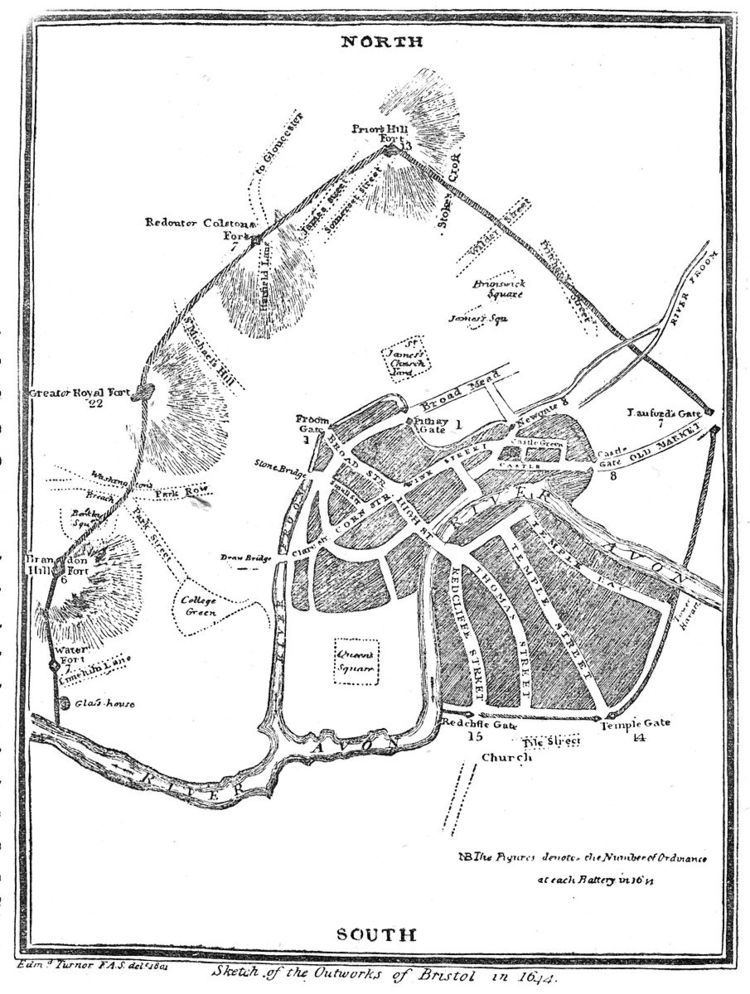 | ||
During the English Civil War (1642–1651), Bristol was a key port on the west coast of England and considered strategically important by both Royalists and Parliamentarians. Initially, the leadership of Bristol wanted to keep the city neutral in the conflict. In 1642, city officials implored Thomas Essex not to occupy the city with his Parliamentarian forces. The city was weakly defended, and Essex entered without much resistance. During the conflict, Bristol was used as a receiving point for the Royalists to accept reinforcements from Ireland. The town was well fortified by the Frome and Avon rivers, as well as a medieval castle, which had been bought by the corporation when the First English Civil War broke out in 1642, and during the Parliamentary defense, earthen artillery forts.
Contents
In these years, Bristol failed to play the important role that might have been expected from a large and rich port. However, the populace had no relish for a civil war in which men were fighting for reasons which did not fill most citizens of Bristol with any great enthusiasm.
Royal Fort House was built on the site of two bastions on the inside of the lines and three on the outside which were fought over during the English Civil War. It was the strongest part of the defenses of Bristol, designed by Dutch military engineer Sir Bernard de Gomme. It was one of the few purpose-built defensive works of the war era. The fort was designed as the western headquarters of the Royalist army under Prince Rupert. It was demolished in 1655.
For Bristol, the central event of the war was the Storming of Bristol by Royalist forces in 1643. The Royalist suffered heavy casualties taking the city, especially among regimental and brigade commanders. After the capture, the city became an important Royalist supply base, and center for communication, administration, and manufacture. The Royalists were dependent on foreign aid and the importation of weaponry. Ships laden with ordnance had to evade Parliamentarian patrols in order to offload their cargo at Bristol.
A typical myth about Bristol during the civil war concerns it capture by Prince Rupert in July 1643. Traditionally it has been accepted that Bristol was attacked by a Royalist army of up to 20,000 men and that William Walker had irresponsibly reduced the garrison to 1,500 infantry and 300 mounted troops, insufficient to man the defensive lines surrounding the city. It is further accepted that these defenses were inadequate and that their weakness was compounded by a serious shortage of ammunition. Despite these problems the Royalists breached the defenses by the chance of discovery of a weak point unknown to the defenders. Once the line was breached, the city was indefensible and the garrison commander, Nathaniel Fiennes, surrendered the city to save his troops and civilian populations; although this account was shown to be inaccurate shortly after the event, it has retained some credibility.
The following are the major events in Bristol or events effecting Bristol during the English Civil War.
1642
1643
1644
1645
In the summer of 1645, Royalist forces were defeated by the New Model Army at the Battle of Langport, in Somerset. Following further victories at Bridgwater and Sherborne, Sir Thomas Fairfax marched on Bristol. Prince Rupert returned to organise the defence of the city. The Parliamentary forces besieged the city and after three weeks attacked, eventually forcing Rupert to surrender on 10 September.
